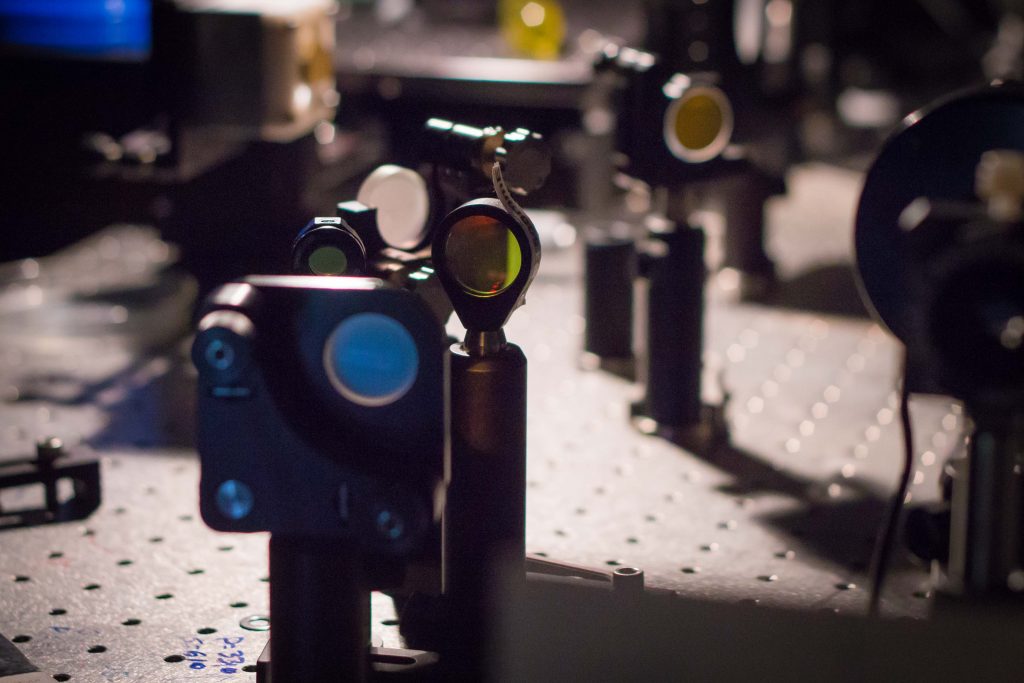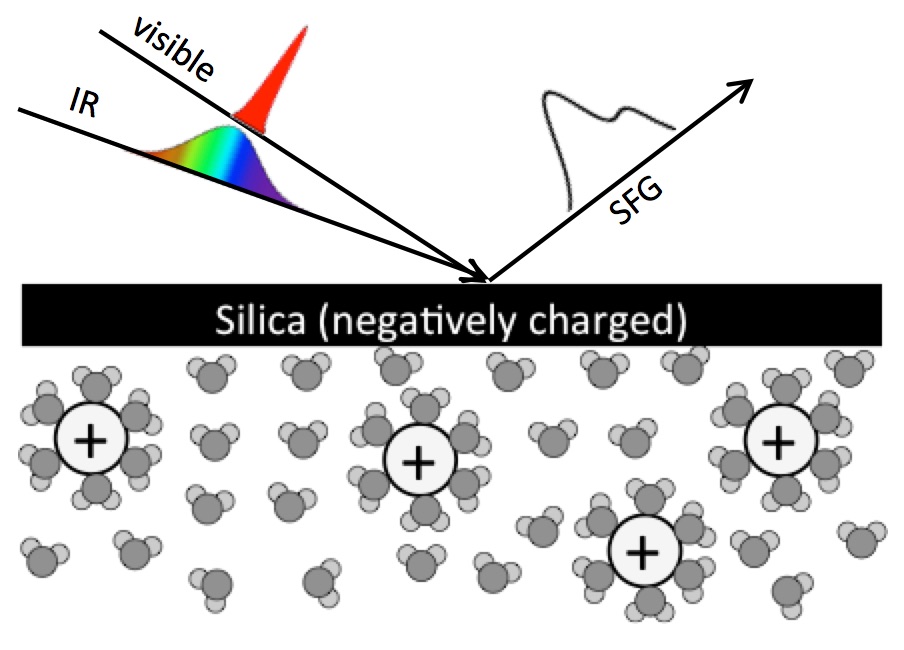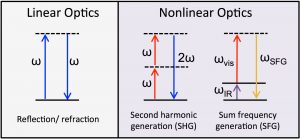 We use second-order nonlinear optical (NLO) methods to probe the water structure at the silica/aqueous interface. NLO methods differ from conventional linear optics (e.g. reflection, refraction, one-photon fluorescence), in that they rely nonlinearly on the intensity of the input light. For second-order NLO methods, signal is only generated where there is a break in inversion symmetry. As a result, signal can only arise in certain ordered systems including certain types of crystals as well as surfaces and interfaces. We use this unique feature of second order NLO methods to our advantage: it allows us to selectively probe the silica/aqueous interface, with signal arising only from molecules right at the interface, and molecules from the bulk solution or amorphous silica generating no response.
We use second-order nonlinear optical (NLO) methods to probe the water structure at the silica/aqueous interface. NLO methods differ from conventional linear optics (e.g. reflection, refraction, one-photon fluorescence), in that they rely nonlinearly on the intensity of the input light. For second-order NLO methods, signal is only generated where there is a break in inversion symmetry. As a result, signal can only arise in certain ordered systems including certain types of crystals as well as surfaces and interfaces. We use this unique feature of second order NLO methods to our advantage: it allows us to selectively probe the silica/aqueous interface, with signal arising only from molecules right at the interface, and molecules from the bulk solution or amorphous silica generating no response.
Sum Frequency Generation
One specific NLO method we use is broadband vibrational sum frequency generation (SFG) spectroscopy. This techniques combines two separate light sources (a narrowband visible and a broadband IR laser), which interact with the sample to generate light at a frequency that is the sum of the frequency of the two incidence sources. In our silica/water experiments we tune the IR light source such that it is vibrationally resonant with the OH stretch of water, thereby selectively probing the response from water molecules at the the interface.

Since only ordered systems can generate SFG signals, we can add different additives to the system and observe changes in the SFG spectrum of water to gain insight on disruption of the water organization at the silica/ aqueous interface. For example, simple addition of NaCl can disrupt ordering of interfacial water, which is manifested as a decrease in intensity in the SFG spectrum. In this case, not only is water being displaced at the interface by cations, but the cations also screen the negative charge of the silica, which in turns decreases the net order of water beyond the first cation layer at the surface. In our lab, we are currently examining the effects of different additives at varying concentrations and pH on SFG spectral shapes and intensities. These changes in water structure at the silica surface could have direct implications for dewatering of silica particles in tailing ponds. For more information on the application of SFG spectroscopy in developing methods for oil sands waste treatment, please see Identifying New Methods for Oil Sands Waste Treatment.
Second Harmonic Generation
In addition to SFG, our lab also utilizes another NLO method called second harmonic generation (SHG). SHG is a specific form of SFG, where two photons of identical frequency interact at the samplet to generate light at double the frequency. For this reason, SHG is often referred to as “frequency doubling.”
SHG is a simpler measurement compared to SFG, as it requires only one incident light source. In addition, SHG intensity from the sample can be related to the degree of water order at the silica/water interface. However, for practical reasons visible or NIR lasers are used for SHG and therefore SHG is not able to selectively probe the vibrational modes of water. As a result, contributions from silica may interfere with the water response, confusing interpretation of the results. Nevertheless, interferences from silica are thought to be small, and SHG can be used to gain insight on overall changes in water ordering.
